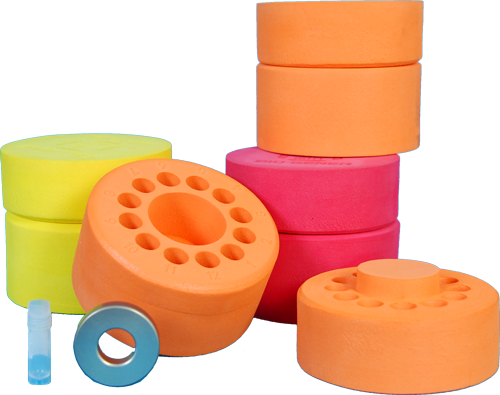Cell Freezing: How to Do It Right
 An established cell line can be hard to replace since aside from being quite pricey, finding a replacement can also take a huge chunk of your time. Now, since all cell cultures are at risk of microbial contamination, genetic drift and senescence, the importance of preserving your precious cell lines takes center stage. What should you do to make sure you don’t run out of established cell lines for future use? Consider freezing them!
An established cell line can be hard to replace since aside from being quite pricey, finding a replacement can also take a huge chunk of your time. Now, since all cell cultures are at risk of microbial contamination, genetic drift and senescence, the importance of preserving your precious cell lines takes center stage. What should you do to make sure you don’t run out of established cell lines for future use? Consider freezing them!
Cryopreservation or the process of freezing a good portion of your cell lines and using it as a seed stock is crucial if you want to make sure you don’t run out of cell samples for your experiments. To ensure the integrity and viability of cultured cells, consider storing them in liquid nitrogen, preferably in the presence of an appropriate cryoprotective agent (e.g., dimethylsulfoxide or DMSO).
The addition of an appropriate cryoprotectant is extremely important since it reduces the risk of ice crystal formation and cell death by maintaining the balance of solutes within the cell and preventing cell dehydration during freezing.
Cryopreservation of Cultured Cells: General Protocol
- Prepare freezing medium. Different cell lines need different freezing mediums so establish the most appropriate medium for your sample. Don’t forget to add a cryoprotective agent (e.g., DMSO or glycerol) to the freezing medium. For best results, store the freezing medium at 2oC to 8oC until use.
- Trypsinize cells. Gently detach adherent and semi-adherent cells from the tissue culture using trypsin/EDTA and resuspend cells in a volume of fresh medium. Take note that the medium should be compatible with the cell type used.
- Determine total number of cells. Perform a cell count with the help of a hemacytometer, cell counter, Trypan Blue exclusion or Countess Automated Cell Counter, and determine percent viability. Calculate how much of the freezing medium is needed according to the desired viable cell density. Note: If you want to ensure good recovery after freezing, cell viability should be more than 90%.
- Centrifuge remaining culture at 150 xg for about 5-10 minutes and gently decant the supernatant. The speed and duration by which you centrifuge your samples should be based on the particular cell type used.
- Resuspend the cell pellet at a concentration of 2-4x106 cells per ml in freezing medium. Allow the cells to sit at room temperature for 15 minutes to allow the cryoprotectant to diffuse into the cell. Transfer 1 ml aliquots of the cell suspension into the appropriate storage vials. Note: The cells should be mixed frequently to maintain homogeneity.
- Freeze the cells. Label the vials and include information on cell type and date. Cool the vials in a controlled rate freezing apparatus and reduce the temperature by about 1°C per minute until the temperature reaches 80oC. You may also keep the vials overnight in an isopropanol chamber at –80°C. Note: Frozen cells will begin to deteriorate when the temperature reaches –50°C.
- Prepare for long term storage. Move the frozen vials to the liquid nitrogen storage area and keep them there for safekeeping until further use.
Some Helpful Tips to Consider:
- To ensure the highest number of viable cells after freezing, consider using actively growing cells harvested from late logarithmic to early stationary phase cells.
- The viability of harvested cells can be improved by employing gentle handling techniques during harvest and concentration. Thus, vigorous pipetting, high speed centrifugation and excessive enzymatic treatment should be avoided at all cost.
- Always use high quality cryoprotectants and sterilize them before use to prevent the introduction of contaminants.
- DMSO is a known neurotoxin so take extreme caution when working with this chemical. Avoid contact with skin at all cost.
- When freezing, glass vials should be kept in a slanted position so the liquid can expand without cracking the glass. To do this, consider placing the vials in a Styrofoam box and placing in a -80°C freezer overnight.
- Don’t forget to wear personal protective equipment.
 An established cell line can be hard to replace since aside from being quite pricey, finding a replacement can also take a huge chunk of your time. Now, since all cell cultures are at risk of microbial contamination, genetic drift and senescence, the importance of preserving your precious cell lines takes center stage. What should you do to make sure you don’t run out of established cell lines for future use? Consider freezing them!
An established cell line can be hard to replace since aside from being quite pricey, finding a replacement can also take a huge chunk of your time. Now, since all cell cultures are at risk of microbial contamination, genetic drift and senescence, the importance of preserving your precious cell lines takes center stage. What should you do to make sure you don’t run out of established cell lines for future use? Consider freezing them!
Leave a Comment